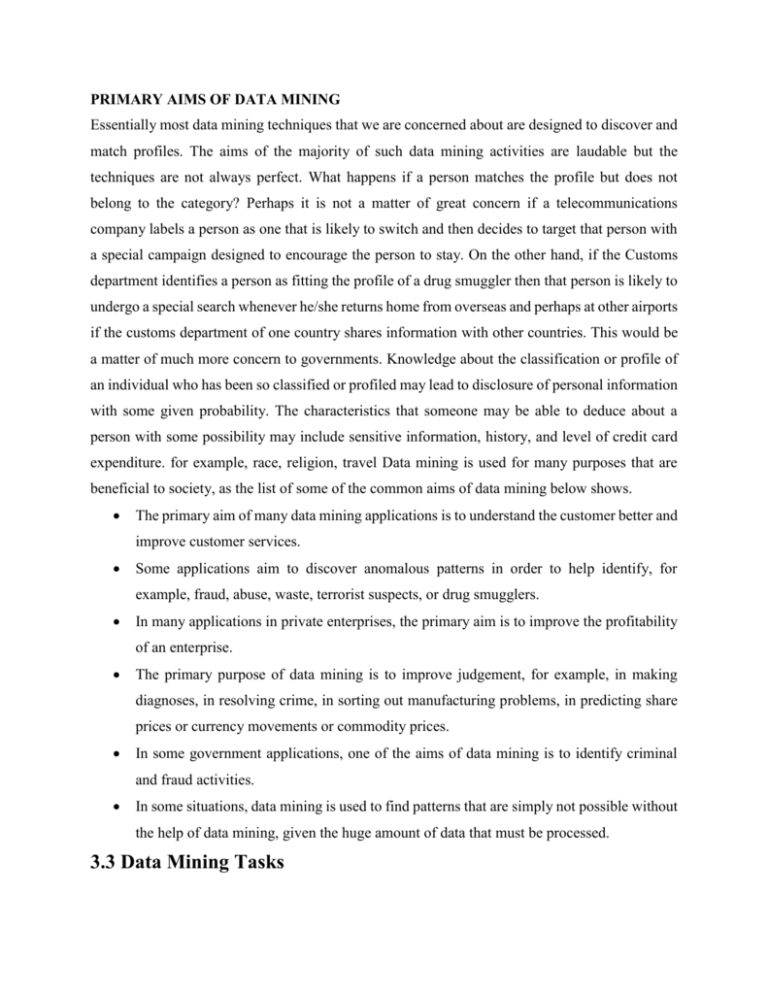variables mining
advertisement

PRIMARY AIMS OF DATA MINING Essentially most data mining techniques that we are concerned about are designed to discover and match profiles. The aims of the majority of such data mining activities are laudable but the techniques are not always perfect. What happens if a person matches the profile but does not belong to the category? Perhaps it is not a matter of great concern if a telecommunications company labels a person as one that is likely to switch and then decides to target that person with a special campaign designed to encourage the person to stay. On the other hand, if the Customs department identifies a person as fitting the profile of a drug smuggler then that person is likely to undergo a special search whenever he/she returns home from overseas and perhaps at other airports if the customs department of one country shares information with other countries. This would be a matter of much more concern to governments. Knowledge about the classification or profile of an individual who has been so classified or profiled may lead to disclosure of personal information with some given probability. The characteristics that someone may be able to deduce about a person with some possibility may include sensitive information, history, and level of credit card expenditure. for example, race, religion, travel Data mining is used for many purposes that are beneficial to society, as the list of some of the common aims of data mining below shows. The primary aim of many data mining applications is to understand the customer better and improve customer services. Some applications aim to discover anomalous patterns in order to help identify, for example, fraud, abuse, waste, terrorist suspects, or drug smugglers. In many applications in private enterprises, the primary aim is to improve the profitability of an enterprise. The primary purpose of data mining is to improve judgement, for example, in making diagnoses, in resolving crime, in sorting out manufacturing problems, in predicting share prices or currency movements or commodity prices. In some government applications, one of the aims of data mining is to identify criminal and fraud activities. In some situations, data mining is used to find patterns that are simply not possible without the help of data mining, given the huge amount of data that must be processed. 3.3 Data Mining Tasks Data mining functionalities are used to specify the kind of patterns to be found in data mining tasks. In general, data mining tasks can be classified into two categories: • Descriptive • predictive Predictive tasks. The objective of these tasks is to predict the value of a particular attribute based on the values of other attribute. Use some variables (independent/explanatory variable) to predict unknown or future values of other variables (dependent/target variable). Description Methods: Here the objective is to derive patterns that summarize the underlying relationships in data. Find human-interpretable patterns that describe the data. There are four core tasks in Data Mining: i. Predictive modeling ii. Association analysis iii. Clustering analysis, iv. Anomaly detection Descriptive mining tasks characterize the general properties of the data in the database. Predictive mining tasks perform inference on the current data in order to make predictions. Describe data mining functionalities, and the kinds of patterns they can discover (or) define each of the following data mining functionalities: characterization, discrimination, association and correlation analysis, classification, prediction, clustering, and evolution analysis. Give examples of each data mining functionality, using a real-life database that you are familiar with. 1). predictive method Find some missing or unavailable data values rather than class labels referred to as prediction. Although prediction may refer to both data value prediction and class label prediction, it is usually confined to data value prediction and thus is distinct from classification. Prediction also encompasses the identification of distribution trends based on the available data. Example: Predicting flooding is difficult problem. One approach is uses monitors placed at various points in the river. These monitors collect data relevant to flood prediction: water level, rain amount, time, humidity etc. These water levels at a potential flooding point in the river can be predicted based on the data collected by the sensors upriver from this point. The prediction must be made with respect to the time the data were collected Classification: It predicts categorical class labels It classifies data (constructs a model) based on the training set and the values (class labels) in a classifying attribute and uses it in classifying new data. Typical Applications o credit approval o target marketing o medical diagnosis o treatment effectiveness analysis Classification can be defined as the process of finding a model (or function) that describes and distinguishes data classes or concepts, for the purpose of being able to use the model to predict the class of objects whose class label is unknown. The derived model is based on the analysis of a set of training data (i.e., data objects whose class label is known). Example: An airport security screening station is used to deter mine if passengers are potential terrorist or criminals. To do this, the face of each passenger is scanned and its basic pattern(distance between eyes, size, and shape of mouth, head etc) is identified. This pattern is compared to entries in a database to see if it matches any patterns that are associated with known offenders A classification model can be represented in various forms, such as 1) IF-THEN rules, student ( class , "undergraduate") AND concentration ( level, "high") ==> class A student (class ,"undergraduate") AND concentrtion (level,"low") ==> class B student (class , "post graduate") ==> class C 2) Decision tree







